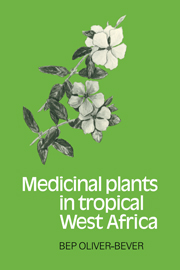Book contents
7 - Oral hypoglycaemic action
Published online by Cambridge University Press: 04 August 2010
Summary
Insulin, a hormone secreted by the β-cells of the Islets of Langerhans in the pancreas, is of utmost importance for the correct metabolism of carbohydrates and fats. It induces the oxidative breakdown of glucose, has a stimulating effect on the synthesis of liver glycogen from glucose and inhibits the formation of liver glycogen from protein and fat.
Diabetes, a condition characterized by hyperglycaemia, is caused by insufficient secretion of insulin or to insufficiency of its peripheral efficacy. Excess of insulin leads to hypoglycaemia; this is easily counteracted if dextrose or a few lumps of sugar are taken at once.
Modern investigations into the biochemistry of diabetes show that its causes and the sites of intervention in the biochemical processes are diverse. Somatostatin, the pituitary and sex hormones, corticosteroids, prostaglandins and vascular modifications of the pancreas can all be involved, together with a straightforward inadequacy in insulin production (Randle et al., 1963; Gupta et al., 1966; Burkhard et al., 1968).
A number of plants have constituents which have antidiabetic properties when taken orally (Oliver-Bever and Zahnd, 1979). There is great diversity in the nature and action of these constituents, but a number of them do seem to belong to certain chemical groups, such as sitosterol glycosides, alkaloids, sulphur oils and flavonoids, and in this chapter I have assembled the plants described into a few groups based on their possible active chemical constituents while at the same time taking into consideration their relation to, or identity with, hypoglycaemic plant constituents found elsewhere.
- Type
- Chapter
- Information
- Medicinal Plants in Tropical West Africa , pp. 245 - 267Publisher: Cambridge University PressPrint publication year: 1986
- 7
- Cited by



